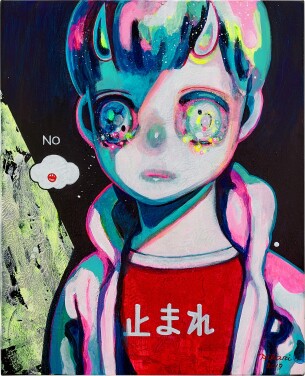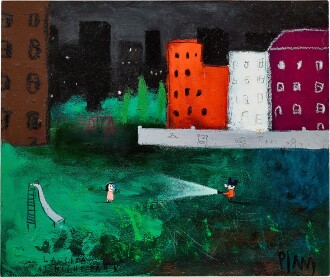W hether it is through a reimagining of youthful daydreams or pop-infused satire of today’s hyper-consumer realm, kawaii pop is instantly recognizable for its kaleidoscope of colors and evocation of childhood heroes. These fantasy worlds present a form of escapism from everyday realities while also asserting an open defiance against social pressures of the times. Japan's kawaii culture entered into the global artworld lexicon in the early 2000s, but it is an aesthetic that has evolved over decades from its roots as a subculture aesthetic to a global phenomenon. The works from this month's Contemporary Showcase explore the many ways kawaii culture has inspired contemporary art from all over the world.
日本的卡哇伊文化早在千禧年初期就在國際藝術界悄悄萌芽,這種美學觀念從次文化的美學土壤中破土而出,經過幾十年的成長,蛻變成風靡全球的當代文化潮流。無論是以懷舊心境演繹童年幻想,還是以普普風格般的手法諷刺過度消費的社會現況,這些遐思妙想和奇幻傳說、如萬花筒般的迷離色彩,是人類逃離繁囂現實的途徑,同時也是對社會壓力的反抗。
kawai-i (adjective): (1) looks miserable and raises sympathy. pitiable. pathetic. piteous. (2) attractive. cannot be neglected. cherished. beloved. (3) has a sweet nature. lovely. (a) (of faces and figures of young women and children) adorable. attractive. (b) (like children) innocent. obedient. touching. (4) (of things and shapes) attractively small. small and beautiful. (5) trivial. pitiful. (used with slight disdain).
卡哇伊 ( kawai-i,形容詞):(1) 神情痛苦、引起同情心,惹人憐憫,淒慘,可憐 (2) 具吸引力,令人無法忽視,受到珍惜,獲得鍾愛 (3) 本質甜美,可愛 (a) (年輕女性和孩童的長相和外形)漂亮,具吸引力 (b) (如孩童般)純潔,順從,動人 (4) (事物和形態) 小巧玲瓏,小巧且美麗 (5) 瑣碎無聊,拙劣可憐 (使用時略帶輕蔑意味)

The manga tradition, a visual form of serial narrative, is responsible for the ubiquity of kawaii aesthetic in everyday life in Japan. Manga emerged in the post-war period as a form of popular entertainment, and through its success evolved far beyond the medium as a true driver of contemporary culture. Notable is the subgenre shojo manga, whose readership is mainly young girls and would typically focus on social relationships and romance subplots. The aesthetic fostered a particular brand of teenage angst, a refusal to grow up by indulging in one’s inner emotional world and the rejection of traditional norms and conformity.
漫畫是一種以視覺靜態圖畫構成的連續敘事。如今在日本人的日常生活裡無處不在的可愛卡通人物,起源亦是漫畫。戰後,漫畫成為大眾的娛樂消遣,而且大行其道,以致後來漫畫逐漸超越原有的意義,成為推動當代文化發展的力量。其中少女漫畫以年輕女孩子為目標,大多集中描寫人際關係和愛情,主角的外形通常十分誇張、偏離寫實,例如水靈靈的超大眼睛和苗條姣好的身材。這種幻想和矯飾反映人們意欲背棄傳統規範,轉投完全脫離現實的純真世界。

Yoshitomo Nara’s protagonists are the embodiment of kawaii. With a big head, round face and large eyes, her attributes suggest angelic innocence, but they are juxtaposed with darker undercurrents of emotion. Childlike innocence is an important notion within kawaii culture; cuteness as a product is traditionally aimed at those in the liminal space between childhood and sexual maturity. Even adult consumers of cute material goods are in a sense gesturing toward a certain youthful fantasy, a recovery of an earlier emotional state. As distinct from products that are expressly designed for children, the kawaii characters are themselves the embodiment of a lost childhood.
奈良美智筆下的小女孩堪稱是「卡哇伊」的化身。大頭圓臉和大眼睛賦予她天使般的純真,但是其內心的陰暗卻與外表截然相反。一般來說,卡哇伊文化的傳統消費者是介乎兒童與成年人之間的群體,因此兒童的純真是卡哇伊文化的重要內涵。從某種意義上而言,受到可愛事物吸引的成年人對青春有一種幻想投射,那是他們重拾早年情感狀態的表現。與專為兒童設計的角色不同,卡哇伊的人物本身就是失落童年的象徵。

Cuteness is primarily the aesthetic of the powerless. The defining characteristics of kawaii have a wide range, with a heavy emphasis on the pitiable. Misshapen little monsters or grotesque creatures are especially lovable because we feel sorry for them and they inspire an instinct to protect them. But cuteness can be weaponized, and many kawaii characters, appearing to be feeble or harmless, are known to be fond of mischief and mayhem.
「卡哇伊」的定義雖然廣泛,但它們都強調一種「惹人憐憫」的特質。無論是奇形怪狀的小妖精,還是光怪陸離的生物,都使我們心生憐憫和保護欲,因此尤其惹人喜歡。然而,可愛也是一種武器,很多看似脆弱無辜的卡哇伊人物其實都埋藏著滋生惡作劇和混亂的種子。

The bubbly little characters that reside in DoodleLand share many traits adjacent to kawaii pop, though they have a very different origin story. Mr Doodle, a.k.a. Sam Cox, developed a doodling style called ‘Graffiti Spaghetti’ which calls to mind the “fluffy hiragana” at the beginnings of kawaii culture. Like Mr Doodle’s style of graffiti, this style of schoolgirl handwriting that became popular in 1970s Japan was full of infectious cuteness – both embracing a distinctive childlike aesthetic.
外號Mr Doodle的山姆・考克斯筆下的「意粉塗鴉」令人聯想起1970年代在日本風靡一時、被稱為卡哇伊文化始祖的「丸文字」潮流。當時,日本女學生之間流行一種字跡圓潤、具鮮明西化特徵的手寫字體,常在字間添上心形及卡通笑臉等圖案。一如Mr Doodle的塗鴉風格,這種字體可愛感十足,惹人喜愛。

Manga and anime trace its roots back to the post-war U.S. occupation in Japan, when the power of American material culture would give rise to a hyper-consumerism and rapid technological change. Characters such as Mickey Mouse and Felix the Cat would become ambassadors of Western influence. Disney would have a sizable influence on early generations of animators, and in subsequent decades Japan’s manga artists would go on to create their own iconic characters: Hello Kitty, Doraemon, Astro Boy, Pokemon and other global cultural exports. Nostalgia continues to be a powerful creative force. These imprints upon childhood memories would in turn recur in the works of young contemporary artists all over the world.
動漫是卡哇伊文化的發源地,而1945至1952年的戰後美軍佔領時期,亦是卡哇伊風潮的一大推動力。當時,美國的物質文化席捲全國,扭轉了日本的社會風貌,崇尚西方主義的過度消費現象應運而生,其中迪士尼角色人物對日本動畫界影響尤深,至今仍深受日本人懷緬。在往後數十年,日本漫畫師創造了吉蒂貓、哆啦A夢、小飛俠阿童木、寵物精靈寶可夢及其他深入民心的文化標誌,為美國、亞洲及全世界的當代藝術家帶來無窮啟發,促進文化互融。

Alice in Wonderland enjoys a particular love in kawaii culture, because many of the themes from Lewis Carroll’s books resonate with the cute fantasy aesthetic, from the girlish protagonist and anthropomorphic animals, to talking flowers and animated objects. Wonderland is an uncanny realm conjured by a hallucinogenic vision of riotous gaudy colors, a garden filled with shadowy supernatural beings.
在卡哇伊文化中,《愛麗絲夢遊仙境》的地位與別不同,廣受大眾喜愛。在路易斯・卡羅的著作中,總會發現天真可愛的少女主角、奇異趣詭的神獸人物和會說話的花朵,一切充滿迷人的奇幻色彩。卡羅筆下的仙境花園色彩絢爛、神秘奇幻,草木暗處俯伏著珍奇可愛的超自然生物,教人心醉神迷。

Many of the most beloved manga characters have their roots in anime or various animated series, such as Doraemon. Celebrating his 50th birthday, the blue robot cat first appeared in 1970 in Coro Coro Comic and in the half-century has been a fixture of many a childhood. From the studios of Shin-Ei Animation, the series “Doraemon” was created during a decade of rapid technological change and captured the imagination of the times. It is fitting that Takashi Murakami would focus on such an icon of kawaii culture in his works. He is often billed as Japan’s Andy Warhol, and just like the American Pop artist, Murakami embraces and encourages contradictions, thriving on disruptions of logic. The artist's signature style, which he calls "superflat", makes no distinction between high and low culture, introducing graphic, anime-inspired images in large swaths of flat color. His design motifs are simultaneously an embrace and critique of consumerism, with which he has a very public relationship.
許多家傳戶曉的動漫人物均源自原創的漫畫系列,哆啦A夢正是一例。這隻藍色機器貓半個世紀以來一直是許多人的童年回憶。1970年,在新銳動畫的悉心製作下,《哆啦A夢》動漫系列在日本電子產業迅速發展的十年間橫空出世。村上隆常被稱為「日本的安迪・沃荷」;一如沃荷,村上隆喜歡在創作上追求矛盾和對比,尤好顛覆常理與邏輯。其代表性的「超扁平」創作手法,從動漫作品中汲取靈感,採用大片色調繪製生動活潑的角色圖案,打破高雅與低俗文化的界限。村上隆本身與名牌和消費主義關係千絲萬縷,他的作品一方面擁抱消費主義,同時又予以抨擊,這種矛盾可謂合符其創作宗旨。

Anthropomorphism is common in children's literature, where we ascribe human attributes to animals. Often wearing clothing and walking on two legs, animals typically appear not as they do in the real world, but as diminished — albeit furry and lovable — versions of ourselves.
兒童文學作品常見擬人化的動物。故事中的小動物總是穿著衣服、以雙腳行走,與真實的形象相去甚遠,恍如披上毛茸茸外衣的迷你版人類。






















































